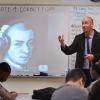Clint Talbott
 Steven Hayward has been appointed the first Visiting Scholar in Conservative Thought and Policy, the University of Colorado Boulder announced last month.
Steven Hayward has been appointed the first Visiting Scholar in Conservative Thought and Policy, the University of Colorado Boulder announced last month. Time magazine dubbed Margaret Mead one of the 20th century’s 100 most influential scientists and thinkers. It also depicted Mead as a sloppy researcher. A University of Colorado Boulder professor has now debunked the source of that slander.
Time magazine dubbed Margaret Mead one of the 20th century’s 100 most influential scientists and thinkers. It also depicted Mead as a sloppy researcher. A University of Colorado Boulder professor has now debunked the source of that slander. The fight against fires begins before the first spark—when homeowners in the wildland-urban interface choose whether to remove trees and bushes near their homes.
The fight against fires begins before the first spark—when homeowners in the wildland-urban interface choose whether to remove trees and bushes near their homes. Sex is apparently like income: People are generally happy when they keep pace with the Joneses. They’re even happier if they get a bit more than their peers.
Sex is apparently like income: People are generally happy when they keep pace with the Joneses. They’re even happier if they get a bit more than their peers. At the 75th Street Wastewater Treatment Facility are, from left to right: Chris Douville, the city of Boulder’s coordinator of wastewatertTreatment; Cole Sigmon, process optimization specialist; David Bortz, assistant professor of applied
At the 75th Street Wastewater Treatment Facility are, from left to right: Chris Douville, the city of Boulder’s coordinator of wastewatertTreatment; Cole Sigmon, process optimization specialist; David Bortz, assistant professor of applied “Nature teaches beasts to know their friends,” wrote Shakespeare. In humans, nature may be less than half of the story, a team led by University of Colorado Boulder researchers has found.
“Nature teaches beasts to know their friends,” wrote Shakespeare. In humans, nature may be less than half of the story, a team led by University of Colorado Boulder researchers has found. While descending Cathedral Spire in Yosemite Valley, Richard Laver lost his route. But after a night stranded on a ledge in darkness, he found an answer that had eluded mathematicians for two decades.
While descending Cathedral Spire in Yosemite Valley, Richard Laver lost his route. But after a night stranded on a ledge in darkness, he found an answer that had eluded mathematicians for two decades. A CU-Boulder anthropologist and a collaborator from Florida have won a $230,000 grant to examine the role of religion in the social and political innovations that led to the emergence of Mesoamerican civilization.
A CU-Boulder anthropologist and a collaborator from Florida have won a $230,000 grant to examine the role of religion in the social and political innovations that led to the emergence of Mesoamerican civilization. CU undergraduate student named as co-author alongside Tom Cech and Leslie Leinwand on groundbreaking paper published in the prestigious journal Nature.
CU undergraduate student named as co-author alongside Tom Cech and Leslie Leinwand on groundbreaking paper published in the prestigious journal Nature. Not just anyone can vividly trace a thread weaving through a zebra’s stripes, a partly crumbling brick wall, a Jackson Pollock painting, a Mozart piano sonata, Dr. Seuss’ “Fox in Socks,” Gwendolyn Brooks’ “We Real Cool,” and even a rap duet by Mos Def and Slick Rick.
Not just anyone can vividly trace a thread weaving through a zebra’s stripes, a partly crumbling brick wall, a Jackson Pollock painting, a Mozart piano sonata, Dr. Seuss’ “Fox in Socks,” Gwendolyn Brooks’ “We Real Cool,” and even a rap duet by Mos Def and Slick Rick.

